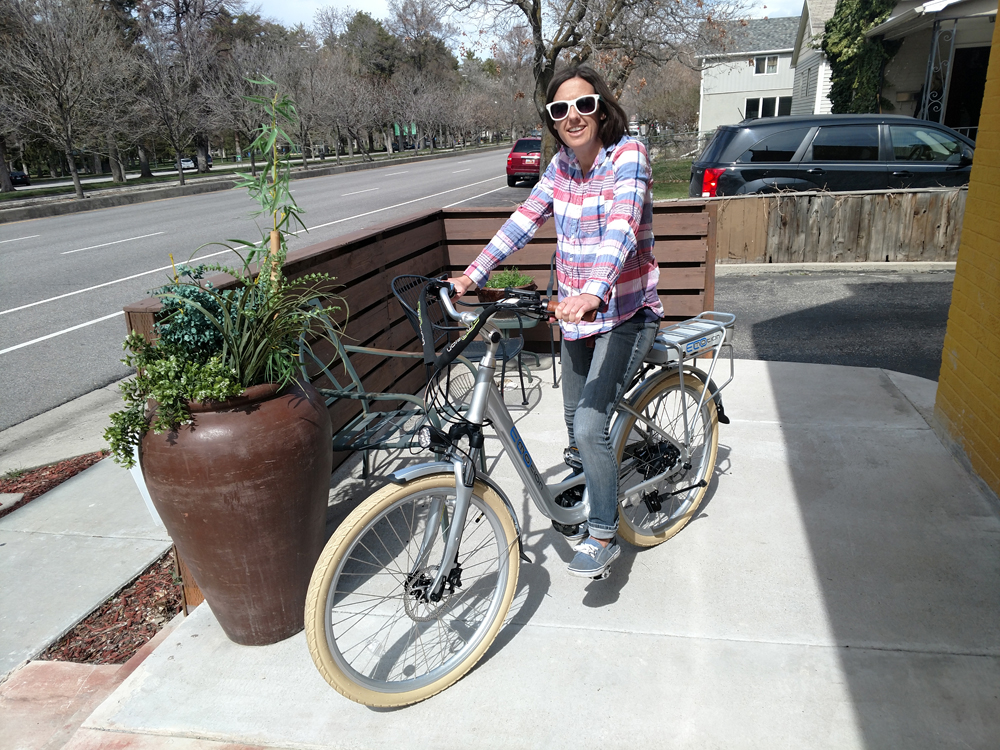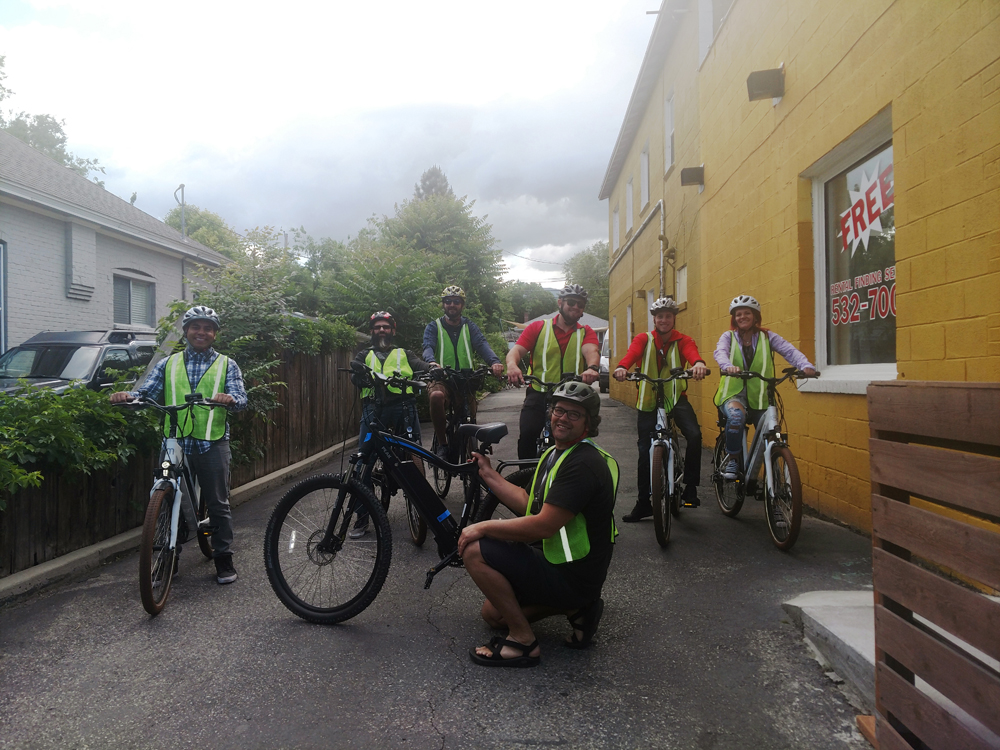By Lou Melini –
Alya Hopkins and Matt Passey of Salt Lake eBikes opened their shop in 2017. Their new shop is located across the street from Liberty Park and is one of the few shops to rent eBikes. When we asked Matt on why they opened the shop, he exclaimed, “They’re fun! And they just took off!” The shop sells Magnum, Eco, Yuba, and Faraday Bikes. They also convert regular bikes to e-bikes through installation of a conversion kit.

Cycling West recently interviewed them to ask them about current e-bike news and issues , and on their commuting experience with e-bikes.
Cycling West: The Wall Street Journal reported on March 24, 2018 on an 800-person study conducted by the University of Tennessee that stated e-bike owners rode (perhaps commuting) 3.6 days/week compared to 2.7 days/week by those riding conventional bikes. What has your experience been in regards to people purchasing e-bikes for commuting? Do you have clientele that have put away conventional bikes to purchase e-bikes for commuting? Does this transition represent a significant impact on sales?
Salt Lake eBikes: Yes, in fact one of our very first customers was commuting from North Salt Lake to downtown Salt Lake on a conventional pedal bike. He bought one of our electric bikes and hasn’t looked back. There have been other customers as well who have said they commute by bike already but would like to make their trip faster. It seems like most people who purchase an e-bike to commute have mainly been commuting by car or public transportation but recently discovered the possibilities with an electric bike.
CW: One of the arguments against e-bikes is speed and safety. The article quoted a New York City bike courier stating that e-bikes “typically reach 20-28 mph” with an “uptick in accidents involving e-bikes and pedestrians”. It is my understanding that e-bikes come in various “classes” and that Class 1 e-bikes typically are governed to have a maximum assist of 20 mph. Can you explain the various classes of e-bikes (assuming I am using the correct technology) and speeds relative to each class. What is the general trend with e-bike acceptance and speeds? What is legal in Utah and perhaps other states? At what point does and e-bike become a motor scooter?
Salt Lake eBikes: I can see the concern with e-bikes and pedestrians. In our business we haven’t personally seen anything. We do let our renters and customers know about bicycle etiquette and speed limits on bike paths. [Note: Municipalities in Utah may regulate e-bikes on sidewalks and paths]. Maybe there should be a statewide education course. There are avid bikers who are used to going 20 mph but you get the average biker who casually pedals then gets that power and they don’t necessarily know how to control that.
There are 3 classes of e-bikes designating their speed and whether pedaling is used or only the motor. Different states have different laws. The federal law defines an e-bike as not exceeding 750 watts or 20 MPH. Utah, however, defines an e-bike as a conventional bike not exceeding 750 watts and a max speed of 20 MPH (motor only), or 28 MPH (motor and pedaling) on a flat surface. [See Utah Code: 41-6a-102] Other than that I haven’t been able to see much research or new laws behind e-bikes. I’m sure they’re coming though. I know California has stricter laws with e-bikes.
[Editor’s note: See also – People for Bikes https://peopleforbikes.org/our-work/e-bikes/ and Utah Code: 41-6a-1115]
CW: The argument against e-bikes included a discussion of batteries (3-year longevity was stated). What has your experience been with battery longevity and regular use by a bike commuter? Does this matter to the person that is achieving the benefits of an assist for their commuting needs?
Salt Lake eBikes: Batteries are surprisingly getting better, lasting longer, more powerful, and getting less expensive. If you’re using an electric bike as a commuter, just think of how much your saving versus driving a car. No gas, no oil changes, sure you have regular maintenance and the battery replacement after a few years but the cost is still lower than owning and driving a car.
CW: The New York Times (March 17, 2018) reported the confiscation of e-bikes by the city from delivery riders. The article pointed out that this was particularly harmful to older (40ish) immigrant delivery riders that needed to support their family. What are some of the Utah laws governing e-bikes? What constitutes legal? Are pedal assist bikes for delivery riders and pedicabs becoming more common in Utah? Could the New York situation happen here in Utah to delivery riders?
Salt Lake eBikes: Every pedicab [in Utah] is electric. You can’t really compare Salt Lake to New York. We have so much more space and less pedestrians. I’ve seen some delivery services starting to use electric and I honestly don’t know why more aren’t using electric. What happened in New York would not happen here for a very long time. We have so much more space than New York. We also don’t have as many “walking neighborhoods”. Most people get in their car to go to the store, take kids to school, and to go to work.

E-Bike Commuter Questions
CW: When did you first become interested in e-bikes and when did it become a business for you?
Matt Passey: 3 years ago I converted my Cannondale to electric. I started riding it every day and stopped using my car as much. I was excited in the morning to get out on the road on my bike. When my wife saw my enthusiasm for riding electric we started questioning why more people aren’t commuting on e-bikes. She started doing research in other cities and discovered Salt Lake was behind the times on the e-bikes movement. Most other major cities had several e-bikes rental shops and had tons of commuters on e-bikes. That’s when we decided to open up shop. Our city is beautiful and unique and what better way to explore it then renting an e-bikes. We also cringe at our air quality here in the valley. We do what we can to do our part in not contributing to it but it wasn’t enough. We thought if we could get even just a few people to ditch their cars and commute on an e-bikes then we have done good for our air.
CW: How much time do you save commuting by e-bike vs. a conventional bike?
MP: My commute is about 7 miles each way. I was not an avid biker before I went electric. If I were to ride a conventional bike it would take probably twice as long. Those bike lanes like on 7th East are where you can really open it up and get some speed under your belt.
CW: How would you compare your transportation choices such as running errands before and since using an e-bike? For example, do you use your car less now that you have an e-bike or have you downsized the number of cars that you (or your family) own?
MP: Errands are way more fun on an e-bike. If I get in my car and its nice outside i’ll start driving and I immediately regret not riding my bike. Sometimes I’ll turn the car around and go get my bike instead. So ya, I use my car way less now that I have an e-bike. We actually have downsized the number of cars in our family since I mostly use a bike.
CW: Are there any routine maintenance needs specific to e-bikes compared to a standard bike? For example is chain wear and tire wear more excessive and need replacing more than a standard bike. (I know, a “it depends” type of question but do the best you can).
MP: Not really, you have the big battery change after a few years other than that the brakes, the gears, the tires all wear about the same. I guess the only difference would be the maintenance comes quicker because you generally put more miles on the e-bike than a conventional.
CW: What would you suggest to a customer that comes to you for an e-bike? What are some of the questions you would ask that customer to assist them with e-bike choices?
MP: I would find out what kind of riding they want to do. My first question to them is “are you ready to have fun?” What’s your level of biking. You basically just listen to the customer about what they want, their capabilities, their restrictions and things like that.
CW: What are the demographics of your customers that come to purchase an e-bike to commute to work? Are they cyclists that previously used a conventional bike or are they previous non-cyclists that seek a bike with ane assist from a battery?
MP: Usually avid bikers. A lot of the times it’s people who used to bike and stopped for whatever reason and they’re looking to get back into it.
MP: (Question for himself) Why is the conventional bike community so critical of a pedal assist bikes?
MP: It’s all the same. We’re all bikers wanting to get outside, take on that trail, get some exercise, feel the wind in our hair.
Shop Information
Salt Lake eBikes
1035 S. 700 E.
Salt Lake City, UT 84105
801-997-0002
saltlakeebikes.com
If you have a suggestion for a commuter profile, especially from Idaho, Montana, Nevada, Wyoming, W. CO, and N. AZ, have a commuter question, or other comments, please send it to [email protected]

